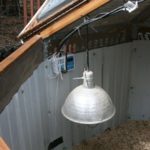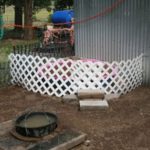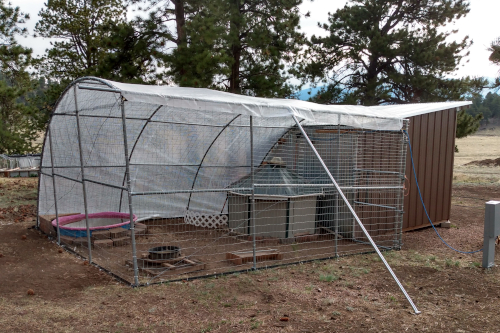DUCK HOUSING
THE "DUCKAGON" & PADDOCK

 We set up our first duck compound here while we were building our house in 2015 for the first ducklings we raised at this location. Our house is a tetra-decagon—14 sides, a round shape like a yurt. So, we decided to make a mini yurt-ish house for the ducks, or what we call the “Duckagon”. It’s actually an octagon, with 8 sides, and comes complete with a skydome on top, just like our house. It has 2 doors that open to a ramp for them to walk down. The 2 doors give us the option to put a partition in the middle when necessary to separate ducks for any reason with an entrance/exit on each side. The top has 2 sections that open for us to access the inside for collecting eggs, cleaning or
We set up our first duck compound here while we were building our house in 2015 for the first ducklings we raised at this location. Our house is a tetra-decagon—14 sides, a round shape like a yurt. So, we decided to make a mini yurt-ish house for the ducks, or what we call the “Duckagon”. It’s actually an octagon, with 8 sides, and comes complete with a skydome on top, just like our house. It has 2 doors that open to a ramp for them to walk down. The 2 doors give us the option to put a partition in the middle when necessary to separate ducks for any reason with an entrance/exit on each side. The top has 2 sections that open for us to access the inside for collecting eggs, cleaning or
 maintaining the heat or light bulbs, etc. The duckagon was made almost entirely with scrap material we had laying around with the exception of the skydome, which is a plastic salad bowl turned upside-down. The flooring is OSB. The walls and ceiling are all insulated with foam insulation.
maintaining the heat or light bulbs, etc. The duckagon was made almost entirely with scrap material we had laying around with the exception of the skydome, which is a plastic salad bowl turned upside-down. The flooring is OSB. The walls and ceiling are all insulated with foam insulation.
Six of the sections have vents that open just under the roof for ventilation. These are generally left open all summer, and all but one are closed throughout the winter.

The duckagon and paddock area are located at the back of a shed. Inside the shed we keep the duck feed, which has been quite handy. Inside, there is also a power strip which holds the extension cords to the duckagon, in addition to a light for the shed. Here we have timers set for the lighting and for the heat lamp inside the duckagon. From about October through April the duckagon and paddock are lighted to increase egg production and it is heated for young ducklings. Once the ducks are adults, the heat will be limited to only the coldest of nights—it is usually set to come on when it gets below 27°, which is an arbitrary number I picked. I figure they’re all wearing their down coats and don’t need a lot of heat.
 The water bowl sits atop a framework covered with ½” hardware cloth, with a hole underneath. The messy water can go through the hardware cloth to the hole below, thus preventing a muddy mess, which if you know ducks, you know muddy messes! The water bowl is topped with a removable wire framework which keeps the ducks from jumping into the bowl. This framework also helps attach the electric cord for the water bowl heater used in winter. We have found that in winter it is best to keep fresh snow shoveled off the hardware cloth as soon as possible, or it will ice up, preventing water from draining through and preventing us from removing the wire top and the bowl for cleaning.
The water bowl sits atop a framework covered with ½” hardware cloth, with a hole underneath. The messy water can go through the hardware cloth to the hole below, thus preventing a muddy mess, which if you know ducks, you know muddy messes! The water bowl is topped with a removable wire framework which keeps the ducks from jumping into the bowl. This framework also helps attach the electric cord for the water bowl heater used in winter. We have found that in winter it is best to keep fresh snow shoveled off the hardware cloth as soon as possible, or it will ice up, preventing water from draining through and preventing us from removing the wire top and the bowl for cleaning.
 The pool (a plastic kiddie-pool) adds lots of fun and enjoyment for the ducks. When we have young ducklings they are not allowed full-time access to the pool. For the youngsters we temporarily add the white lattice fence, and only let them use the pool for short periods of time when it’s warm. Tim has equipped the pool with a drain for easy cleaning. You may notice the two-tone colors of the pool. One of our pools had sprung a leak, and when we replaced it, we decided to cut off the rim of the old pool and add it underneath the new pool for added strength. We are very glad we did this—it definitely adds strength and helps the pool stand up more solidly. The pool area is surrounded by bricks, as you see—partly to keep the surrounding edge
The pool (a plastic kiddie-pool) adds lots of fun and enjoyment for the ducks. When we have young ducklings they are not allowed full-time access to the pool. For the youngsters we temporarily add the white lattice fence, and only let them use the pool for short periods of time when it’s warm. Tim has equipped the pool with a drain for easy cleaning. You may notice the two-tone colors of the pool. One of our pools had sprung a leak, and when we replaced it, we decided to cut off the rim of the old pool and add it underneath the new pool for added strength. We are very glad we did this—it definitely adds strength and helps the pool stand up more solidly. The pool area is surrounded by bricks, as you see—partly to keep the surrounding edge

from getting muddy, partly to give the ducks a bit of a platform to get into the pool. Young ducklings get a few extra bricks to help them get in & out of the pool on their own, but after the ducks are full size, just one brick will remain on the inside and two on the outside for access.
The paddock area is lined with some field fencing around the lower 4 feet, and a high-quality 2×2″ bird netting along the upper sides and the top, to keep predator animals or birds out and ducks in. This has worked quite well for us. The first year, when the ducks were small, we discovered they could escape through the field fence, so some plastic snow fencing was added, which also keeps out the squirrels & other small mammals (but not the mice). After 4 years, we’ve only had 2 break-ins, just this year. Something appeared to have climbed above the top of the field fence and ripped through the netting, but was unable to get to the ducks that were locked in their house nice and snug.
Adult ducks are allowed to freely roam outside the paddock during the day. We used to lock them in the paddock when we were away from home during the day, but eventually allowed them to stay out when we are gone for a few hours. The ducks seem to know whether they need to go into the paddock or duckagon where it’s safer if needed. Although Goldie (the watch dog!) is locked in her area when we’re gone, she has a nice, loud bark and the predators have not been a problem. At night they are locked inside the duckagon, and the gate to the paddock is also locked shut. In the mornings, they are left in the paddock until I think all eggs have been laid. This keeps me from having to go on an egg hunt!
The duck paddock is located just to the side of the house where we can easily see them. The top photo was taken from our deck. It’s also located near a water hydrant, and not far from the garden. They are allowed in the garden, but because of our raised beds, they are unable to reach the plants for eating. That’s a good thing, but unfortunately they are also unable to get into the beds to eat the grubs or other bugs. Oh well—I just dig the grubs out and throw them to the ducks, who gobble them up voraciously.
Before moving here, we had a similarly elaborate duck paddock and house. One of our friends called it, “Duck Med.” This one isn’t far off!

Since the original writing of this post, the paddock was revised in 2020 to provide a cover (similar to what we had done in Wellington). This really helps keep the snow & rain out. The ducks probably don’t care, but it makes it much easier for us to maneuver the paddock area and keeps the water out of their food.
Stay tuned…we have plans for more changes in 2023 which may include a duck garden of veggies just for them!
- Laurie
- Revised March 1, 2023
